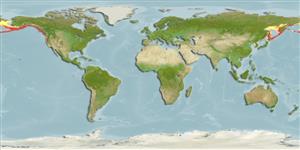Environment: milieu / climate zone / depth range / distribution range
Ecologia
marinhas demersal; intervalo de profundidade 0 - 450 m (Ref. 58496). Temperate; 66°N - 34°N
North Pacific: Kamchatka, Russia and along the Commander and Aleutian Islands to St. Paul Island in the Bering Sea and to Monterey Bay, California, USA.
Tamanho / Peso / Idade
Maturity: Lm ? range ? - ? cm
Max length : 51.0 cm TL macho/indeterminado; (Ref. 2850); peso máx. publicado: 1.1 kg (Ref. 40637)
Descrição suscinta
Chaves de identificação | Morfologia | Morfometria
Espinhos dorsais (total) : 10 - 12; Raios dorsais (total) : 18 - 20; Espinhos anais: 0; Raios anais : 13 - 16; Vértebras: 35. Dorsal with moderate notches in the spinous part after the third spine, and between the spinous and rayed parts; caudal bluntly rounded; pelvic fins larger in males (Ref. 6885). Color variable, predominately red, sometimes brilliant red, with brown, white, and black mottling and spotting all over; there are four irregular dark saddles across back; the caudal fin with darker rays, sometimes with vertical light bars; some large males with darkly spotted pelvic fins (including base of pectorals) (Ref. 6885).
Usually near shore in rocky areas (Ref. 2850), from intertidal areas to 275 m depth (Ref. 6793). Adults feed on crabs, barnacles, and mussels (Ref. 6885). Good eating (Ref. 2850).
Ciclo de vida ou comportamento de acasalamento
Maturities | Reprodução | Spawnings | Egg(s) | Fecundities | Larvas
Eschmeyer, W.N., E.S. Herald and H. Hammann, 1983. A field guide to Pacific coast fishes of North America. Boston (MA, USA): Houghton Mifflin Company. xii+336 p. (Ref. 2850)
Status na Lista Vermelha da UICN (Ref. 130435)
Ameaça para os humanos
Harmless
Uso pelos humanos
Pescarias: espécies comerciais; peixe esportivo: sim; Aquário: Aquários públicos
Ferramentas
Relatórios especiais
Baixar XML
Fontes da internet
Estimates based on models
Preferred temperature (Ref.
123201): 0.9 - 7.7, mean 4.4 °C (based on 386 cells).
Índice de diversidade filogenética (Ref.
82804): PD
50 = 0.5156 [Uniqueness, from 0.5 = low to 2.0 = high].
Bayesian length-weight: a=0.00676 (0.00300 - 0.01523), b=3.17 (2.98 - 3.36), in cm total length, based on LWR estimates for this (Sub)family-body shape (Ref.
93245).
Nível Trófico (Ref.
69278): 3.5 ±0.6 se; based on diet studies.
Resiliência (Ref.
120179): Muito baixo(a), tempo mínimo de duplicação da população maior que 14 anos (Preliminary K or Fecundity.).
Fishing Vulnerability (Ref.
59153): Moderate vulnerability (40 of 100).
